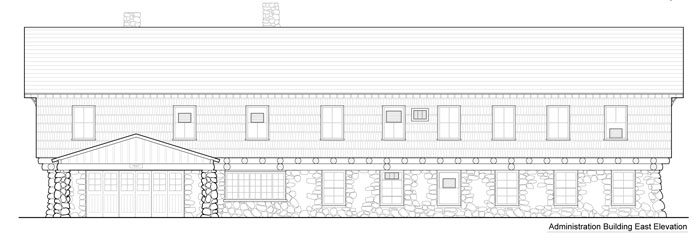
Benjamin Stinnett (B.L.A. ’12) is shown in summer 2012 during a short weekend excursion to Clouds Rest, a 9,930-foot elevation mountain just east of the Yosemite Valley. The small glacial lake behind him was located along the trail.
By Liana Bugslag
Landscape architecture alumnus Benjamin Stinnett (B.L.A.’ 12) has been on quite the journey since he finished up his studies at the University of Arkansas.
Upon his graduation last spring, Stinnett immediately took an internship through the National Council for Preservation Education (NCPE) at Yosemite National Park in central California. During the 12-week internship, he worked within the Branch of History, Architecture and Landscapes (HAL), where he assisted the park’s historical landscape architect and historical architects with an assortment of projects, including condition assessments of historic structures, landscape and architectural documentation, landscape inventory and analysis.
He gained the skills and passion for landscape preservation as a student.
“While attending the University of Arkansas, I was able to explore the historic preservation and documentation side of landscape architecture through cultural landscape preservation coursework with professor Kimball Erdman,” Stinnett said.
Erdman guided Stinnett and six of his classmates through the documentation of the cemetery at the Rohwer War Relocation Center, a Japanese-American internment camp in southeast Arkansas, using the Historic American Landscape Survey (HALS) guidelines.
Stinnett also completed an independent study with Erdman as an extension of his senior capstone design project, in which he researched the Gypsy Camp for Girls, a historic summer camp in the Ozark Mountains of northwest Arkansas.
“These projects, along with the landscape architecture core classes, were important in my gaining the knowledge and skills I used throughout the National Park Service internship,” Stinnett said. “The internship at Yosemite really interested me because it focused on the historic preservation aspects of landscape architecture within the setting of a national park. Plus, I didn’t mind the idea of spending a summer at Yosemite.”
For his main project last summer at Yosemite, Stinnett helped the park’s historical landscape architect conduct fieldwork and compile data for the Scenic Vista Management Plan appendix to the Merced River Plan. The plan inventoried and considered work to be completed at 181 potential vista points throughout the park. Stinnett also created scaled elevation drawings of the Yosemite Administration Building, which were included in a Historic Structures Report being written by a park historical architect.

Stinnett created this scaled elevation drawing of the Yosemite Administration Building for a Historic Structures Report being written by a park historical architect.
An ongoing project throughout the summer was working with another intern to complete condition assessments on approximately 100 park structures – including trails, residences, tent cabins, cottages and the valley chapel – for the park service’s List of Classified Structures.
For one of the final projects, he used Arc GIS mapping and analysis software to work with the GPS data collected in the field. This point data mapped historic landscape features on the Generals Highway in Sequoia and Kings Canyon National Parks – contributing features such as culverts, walls and retaining walls.
“My experience went above and beyond my expectations. It helped me reinforce skills such as site analysis, cultural landscape documentation, AutoCAD and GIS, and plant identification from my undergraduate degree and apply them into a professional environment. Additionally, it was a great introduction into the next step of my education,” Stinnett said.
That next step was to attend the University of Oregon and pursue a Master’s Degree in Historic Preservation. Stinnett found out he had been accepted into the University of Oregon two months prior to graduating from the University of Arkansas. The Siloam Springs native packed his car and began a road trip to California and, eventually, Eugene, Ore., for the fall 2012 term.
The two-year graduate program is part of the University of Oregon’s School of Architecture and Allied Arts. Stinnett chose the school because its historic preservation program had strong ties to the landscape architecture and architecture departments.
“The program at Oregon provided a strong, interdisciplinary study format. The program has allowed me to take both architecture and landscape preservation courses,” he said.
By attending the University of Oregon, he is also able to study under Robert Melnick, a professor and former dean, who is a nationally and internationally recognized expert in cultural landscape evaluation and historic landscape preservation planning.
“This will be extremely beneficial in the continuation of my education,” Stinnett said.
Just a few weeks ago, Stinnett returned to Yosemite over Spring Break to volunteer his time and talents. He helped the park’s historical landscape architect document the Yosemite Valley Cemetery, the final resting place for many Yosemite natives and early pioneers. They completed descriptions and condition assessments of the cemetery’s 34 burial markers and landscape features.
Stinnett plans to graduate from the historic preservation program in the spring of 2014, at which time he hopes to find a job with the National Park Service. And for those who wonder if he will ever call Arkansas home again, he absolutely would – if the right job opened up.
But, no matter where his path takes him, he will always remember the University of Arkansas as the first step of the journey.